Analysis of Accounting Concepts within DOMINO LIMITED Financials
VerifiedAdded on 2022/11/13
|12
|3647
|297
Report
AI Summary
This report delves into various accounting concepts, providing a comprehensive overview of their definitions and practical applications, particularly within the context of DOMINO LIMITED. It explores fundamental principles like the business entity, money measurement, going concern, accounting period, cost, dual aspect, realization, accrual, and matching concepts. The report analyzes financial reporting issues faced by companies like DOMINO LIMITED, including technological advancements and regulatory changes, and how the company addresses them. It also examines the conceptual framework, emphasizing the historical cost method. The analysis covers assets, non-current assets, liabilities, and the processes of revaluation and impairment of non-current assets, providing a detailed understanding of how these concepts influence financial statements and decision-making within the company.
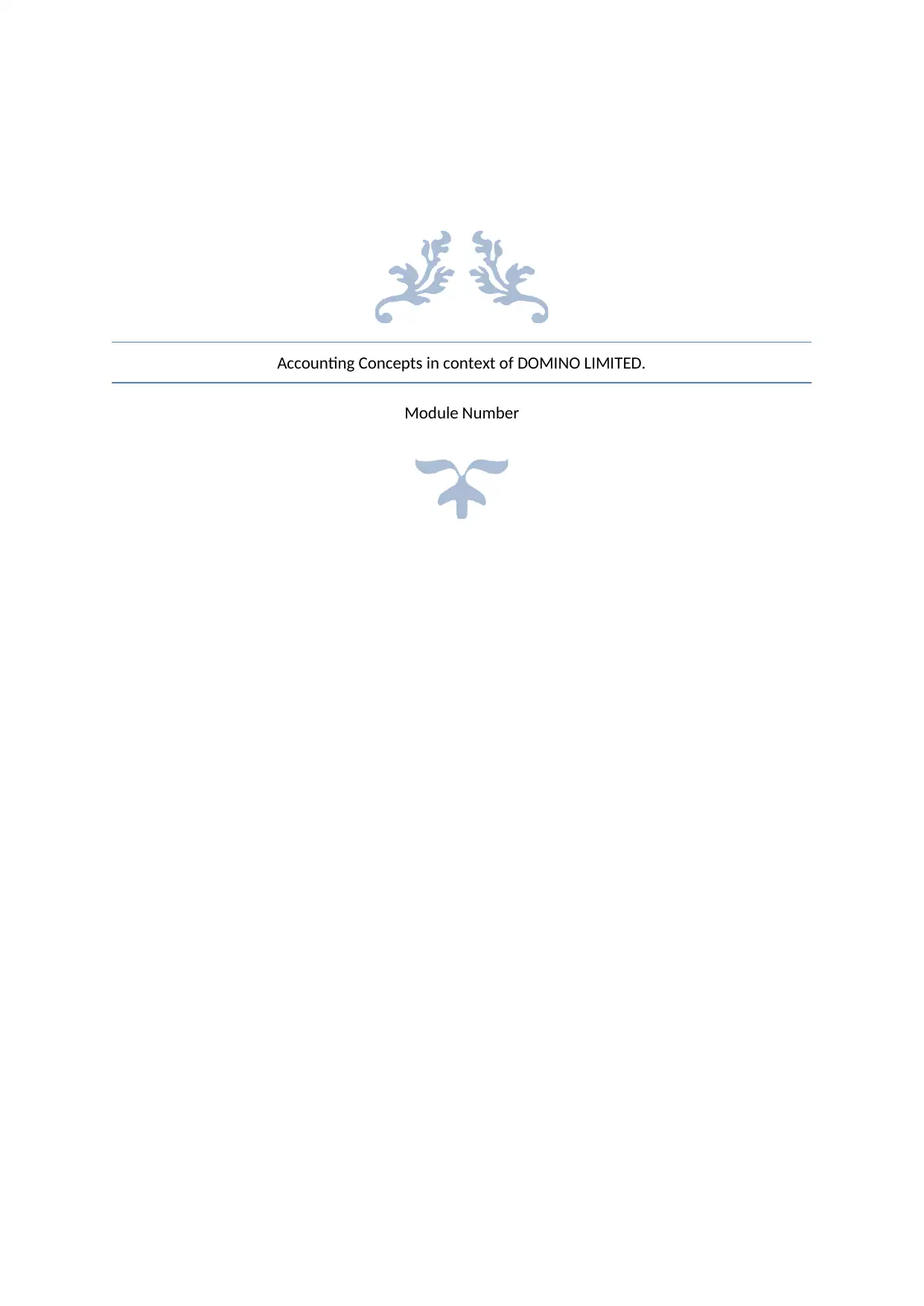
Accounting Concepts in context of DOMINO LIMITED.
Module Number
Module Number
Paraphrase This Document
Need a fresh take? Get an instant paraphrase of this document with our AI Paraphraser
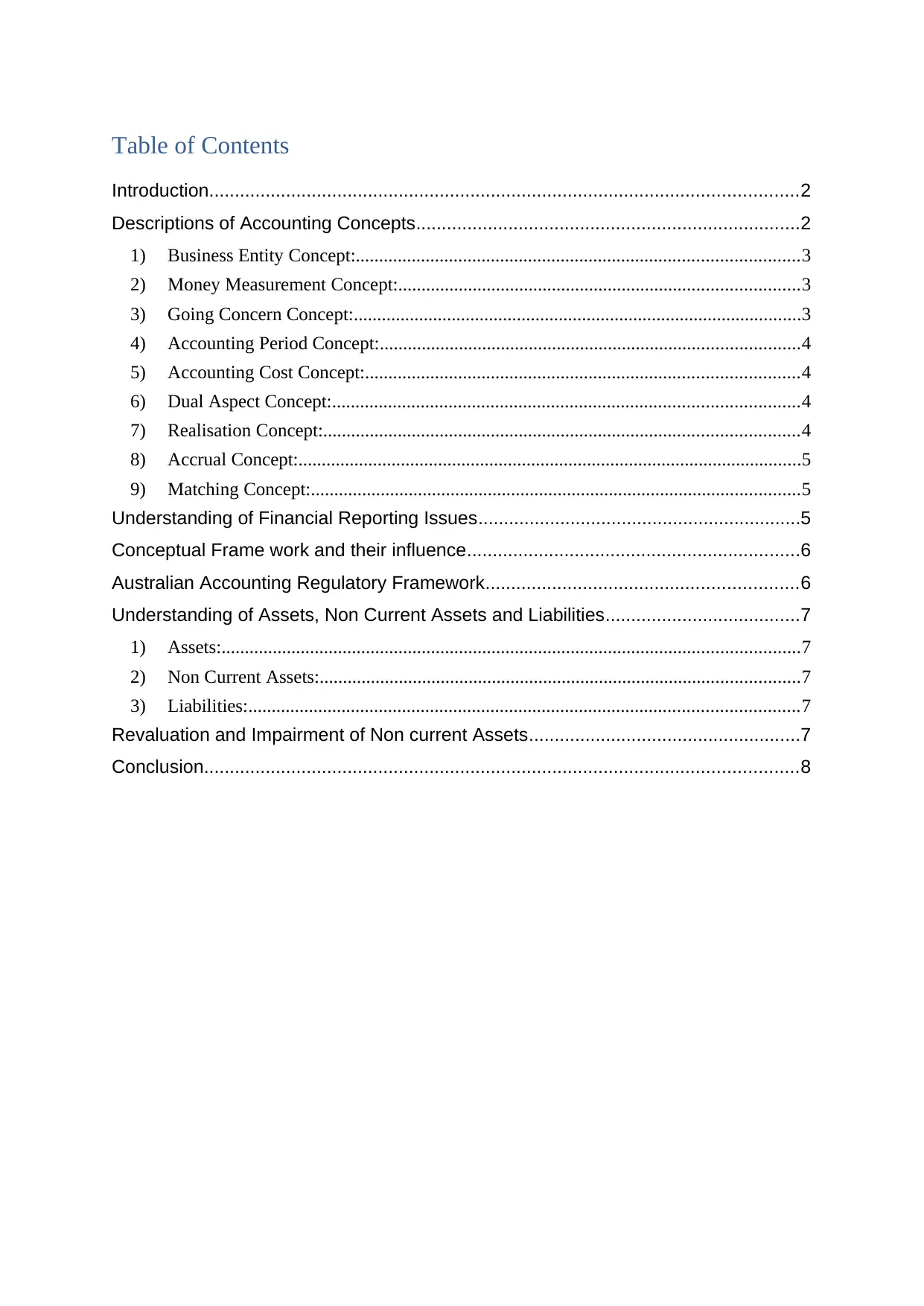
Table of Contents
Introduction...................................................................................................................2
Descriptions of Accounting Concepts...........................................................................2
1) Business Entity Concept:...............................................................................................3
2) Money Measurement Concept:......................................................................................3
3) Going Concern Concept:................................................................................................3
4) Accounting Period Concept:..........................................................................................4
5) Accounting Cost Concept:.............................................................................................4
6) Dual Aspect Concept:....................................................................................................4
7) Realisation Concept:......................................................................................................4
8) Accrual Concept:............................................................................................................5
9) Matching Concept:.........................................................................................................5
Understanding of Financial Reporting Issues...............................................................5
Conceptual Frame work and their influence.................................................................6
Australian Accounting Regulatory Framework.............................................................6
Understanding of Assets, Non Current Assets and Liabilities......................................7
1) Assets:............................................................................................................................7
2) Non Current Assets:.......................................................................................................7
3) Liabilities:......................................................................................................................7
Revaluation and Impairment of Non current Assets.....................................................7
Conclusion....................................................................................................................8
Introduction...................................................................................................................2
Descriptions of Accounting Concepts...........................................................................2
1) Business Entity Concept:...............................................................................................3
2) Money Measurement Concept:......................................................................................3
3) Going Concern Concept:................................................................................................3
4) Accounting Period Concept:..........................................................................................4
5) Accounting Cost Concept:.............................................................................................4
6) Dual Aspect Concept:....................................................................................................4
7) Realisation Concept:......................................................................................................4
8) Accrual Concept:............................................................................................................5
9) Matching Concept:.........................................................................................................5
Understanding of Financial Reporting Issues...............................................................5
Conceptual Frame work and their influence.................................................................6
Australian Accounting Regulatory Framework.............................................................6
Understanding of Assets, Non Current Assets and Liabilities......................................7
1) Assets:............................................................................................................................7
2) Non Current Assets:.......................................................................................................7
3) Liabilities:......................................................................................................................7
Revaluation and Impairment of Non current Assets.....................................................7
Conclusion....................................................................................................................8
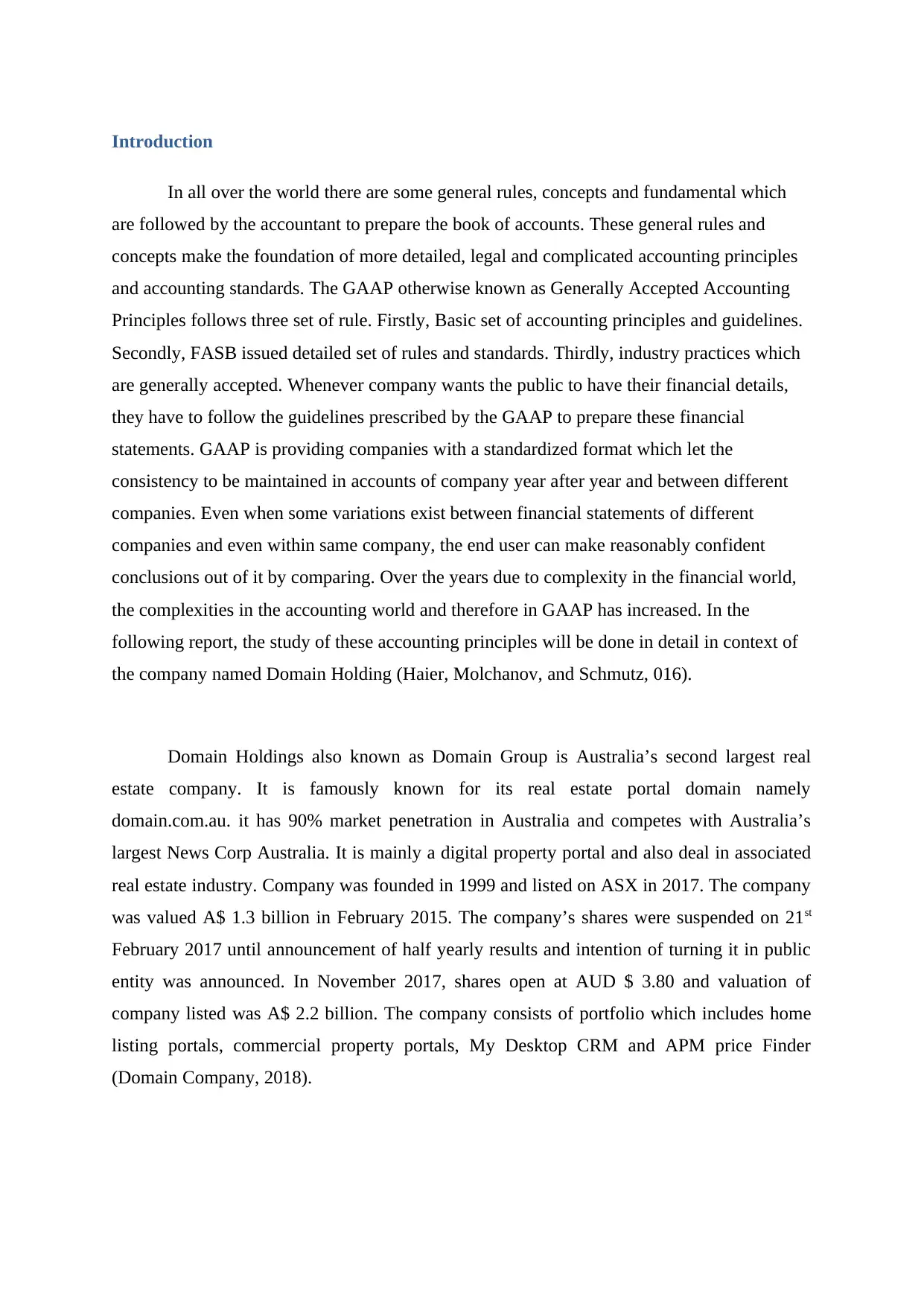
Introduction
In all over the world there are some general rules, concepts and fundamental which
are followed by the accountant to prepare the book of accounts. These general rules and
concepts make the foundation of more detailed, legal and complicated accounting principles
and accounting standards. The GAAP otherwise known as Generally Accepted Accounting
Principles follows three set of rule. Firstly, Basic set of accounting principles and guidelines.
Secondly, FASB issued detailed set of rules and standards. Thirdly, industry practices which
are generally accepted. Whenever company wants the public to have their financial details,
they have to follow the guidelines prescribed by the GAAP to prepare these financial
statements. GAAP is providing companies with a standardized format which let the
consistency to be maintained in accounts of company year after year and between different
companies. Even when some variations exist between financial statements of different
companies and even within same company, the end user can make reasonably confident
conclusions out of it by comparing. Over the years due to complexity in the financial world,
the complexities in the accounting world and therefore in GAAP has increased. In the
following report, the study of these accounting principles will be done in detail in context of
the company named Domain Holding (Haier, Molchanov, and Schmutz, 016).
Domain Holdings also known as Domain Group is Australia’s second largest real
estate company. It is famously known for its real estate portal domain namely
domain.com.au. it has 90% market penetration in Australia and competes with Australia’s
largest News Corp Australia. It is mainly a digital property portal and also deal in associated
real estate industry. Company was founded in 1999 and listed on ASX in 2017. The company
was valued A$ 1.3 billion in February 2015. The company’s shares were suspended on 21st
February 2017 until announcement of half yearly results and intention of turning it in public
entity was announced. In November 2017, shares open at AUD $ 3.80 and valuation of
company listed was A$ 2.2 billion. The company consists of portfolio which includes home
listing portals, commercial property portals, My Desktop CRM and APM price Finder
(Domain Company, 2018).
In all over the world there are some general rules, concepts and fundamental which
are followed by the accountant to prepare the book of accounts. These general rules and
concepts make the foundation of more detailed, legal and complicated accounting principles
and accounting standards. The GAAP otherwise known as Generally Accepted Accounting
Principles follows three set of rule. Firstly, Basic set of accounting principles and guidelines.
Secondly, FASB issued detailed set of rules and standards. Thirdly, industry practices which
are generally accepted. Whenever company wants the public to have their financial details,
they have to follow the guidelines prescribed by the GAAP to prepare these financial
statements. GAAP is providing companies with a standardized format which let the
consistency to be maintained in accounts of company year after year and between different
companies. Even when some variations exist between financial statements of different
companies and even within same company, the end user can make reasonably confident
conclusions out of it by comparing. Over the years due to complexity in the financial world,
the complexities in the accounting world and therefore in GAAP has increased. In the
following report, the study of these accounting principles will be done in detail in context of
the company named Domain Holding (Haier, Molchanov, and Schmutz, 016).
Domain Holdings also known as Domain Group is Australia’s second largest real
estate company. It is famously known for its real estate portal domain namely
domain.com.au. it has 90% market penetration in Australia and competes with Australia’s
largest News Corp Australia. It is mainly a digital property portal and also deal in associated
real estate industry. Company was founded in 1999 and listed on ASX in 2017. The company
was valued A$ 1.3 billion in February 2015. The company’s shares were suspended on 21st
February 2017 until announcement of half yearly results and intention of turning it in public
entity was announced. In November 2017, shares open at AUD $ 3.80 and valuation of
company listed was A$ 2.2 billion. The company consists of portfolio which includes home
listing portals, commercial property portals, My Desktop CRM and APM price Finder
(Domain Company, 2018).
⊘ This is a preview!⊘
Do you want full access?
Subscribe today to unlock all pages.

Trusted by 1+ million students worldwide
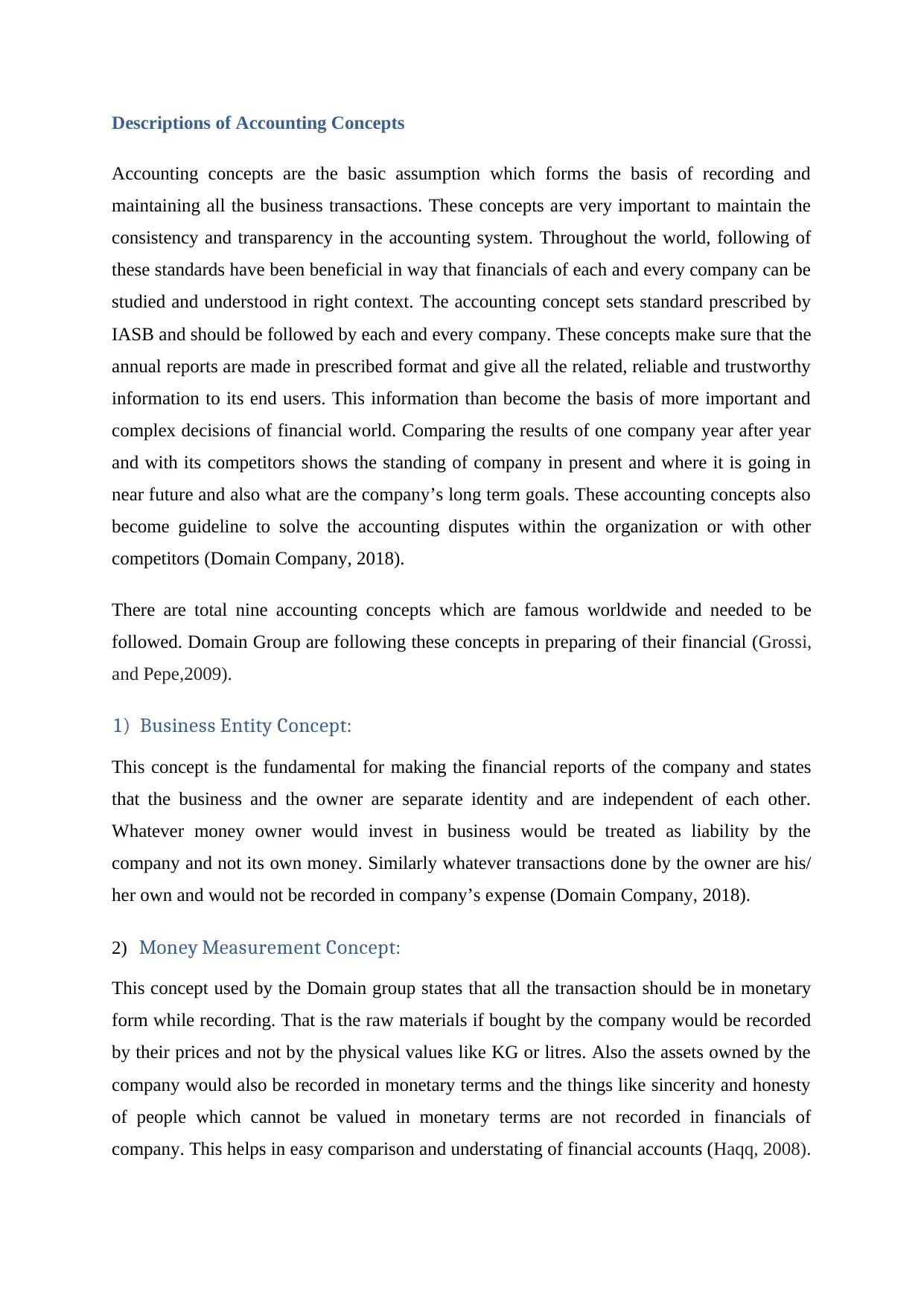
Descriptions of Accounting Concepts
Accounting concepts are the basic assumption which forms the basis of recording and
maintaining all the business transactions. These concepts are very important to maintain the
consistency and transparency in the accounting system. Throughout the world, following of
these standards have been beneficial in way that financials of each and every company can be
studied and understood in right context. The accounting concept sets standard prescribed by
IASB and should be followed by each and every company. These concepts make sure that the
annual reports are made in prescribed format and give all the related, reliable and trustworthy
information to its end users. This information than become the basis of more important and
complex decisions of financial world. Comparing the results of one company year after year
and with its competitors shows the standing of company in present and where it is going in
near future and also what are the company’s long term goals. These accounting concepts also
become guideline to solve the accounting disputes within the organization or with other
competitors (Domain Company, 2018).
There are total nine accounting concepts which are famous worldwide and needed to be
followed. Domain Group are following these concepts in preparing of their financial (Grossi,
and Pepe,2009).
1) Business Entity Concept:
This concept is the fundamental for making the financial reports of the company and states
that the business and the owner are separate identity and are independent of each other.
Whatever money owner would invest in business would be treated as liability by the
company and not its own money. Similarly whatever transactions done by the owner are his/
her own and would not be recorded in company’s expense (Domain Company, 2018).
2) Money Measurement Concept:
This concept used by the Domain group states that all the transaction should be in monetary
form while recording. That is the raw materials if bought by the company would be recorded
by their prices and not by the physical values like KG or litres. Also the assets owned by the
company would also be recorded in monetary terms and the things like sincerity and honesty
of people which cannot be valued in monetary terms are not recorded in financials of
company. This helps in easy comparison and understating of financial accounts (Haqq, 2008).
Accounting concepts are the basic assumption which forms the basis of recording and
maintaining all the business transactions. These concepts are very important to maintain the
consistency and transparency in the accounting system. Throughout the world, following of
these standards have been beneficial in way that financials of each and every company can be
studied and understood in right context. The accounting concept sets standard prescribed by
IASB and should be followed by each and every company. These concepts make sure that the
annual reports are made in prescribed format and give all the related, reliable and trustworthy
information to its end users. This information than become the basis of more important and
complex decisions of financial world. Comparing the results of one company year after year
and with its competitors shows the standing of company in present and where it is going in
near future and also what are the company’s long term goals. These accounting concepts also
become guideline to solve the accounting disputes within the organization or with other
competitors (Domain Company, 2018).
There are total nine accounting concepts which are famous worldwide and needed to be
followed. Domain Group are following these concepts in preparing of their financial (Grossi,
and Pepe,2009).
1) Business Entity Concept:
This concept is the fundamental for making the financial reports of the company and states
that the business and the owner are separate identity and are independent of each other.
Whatever money owner would invest in business would be treated as liability by the
company and not its own money. Similarly whatever transactions done by the owner are his/
her own and would not be recorded in company’s expense (Domain Company, 2018).
2) Money Measurement Concept:
This concept used by the Domain group states that all the transaction should be in monetary
form while recording. That is the raw materials if bought by the company would be recorded
by their prices and not by the physical values like KG or litres. Also the assets owned by the
company would also be recorded in monetary terms and the things like sincerity and honesty
of people which cannot be valued in monetary terms are not recorded in financials of
company. This helps in easy comparison and understating of financial accounts (Haqq, 2008).
Paraphrase This Document
Need a fresh take? Get an instant paraphrase of this document with our AI Paraphraser
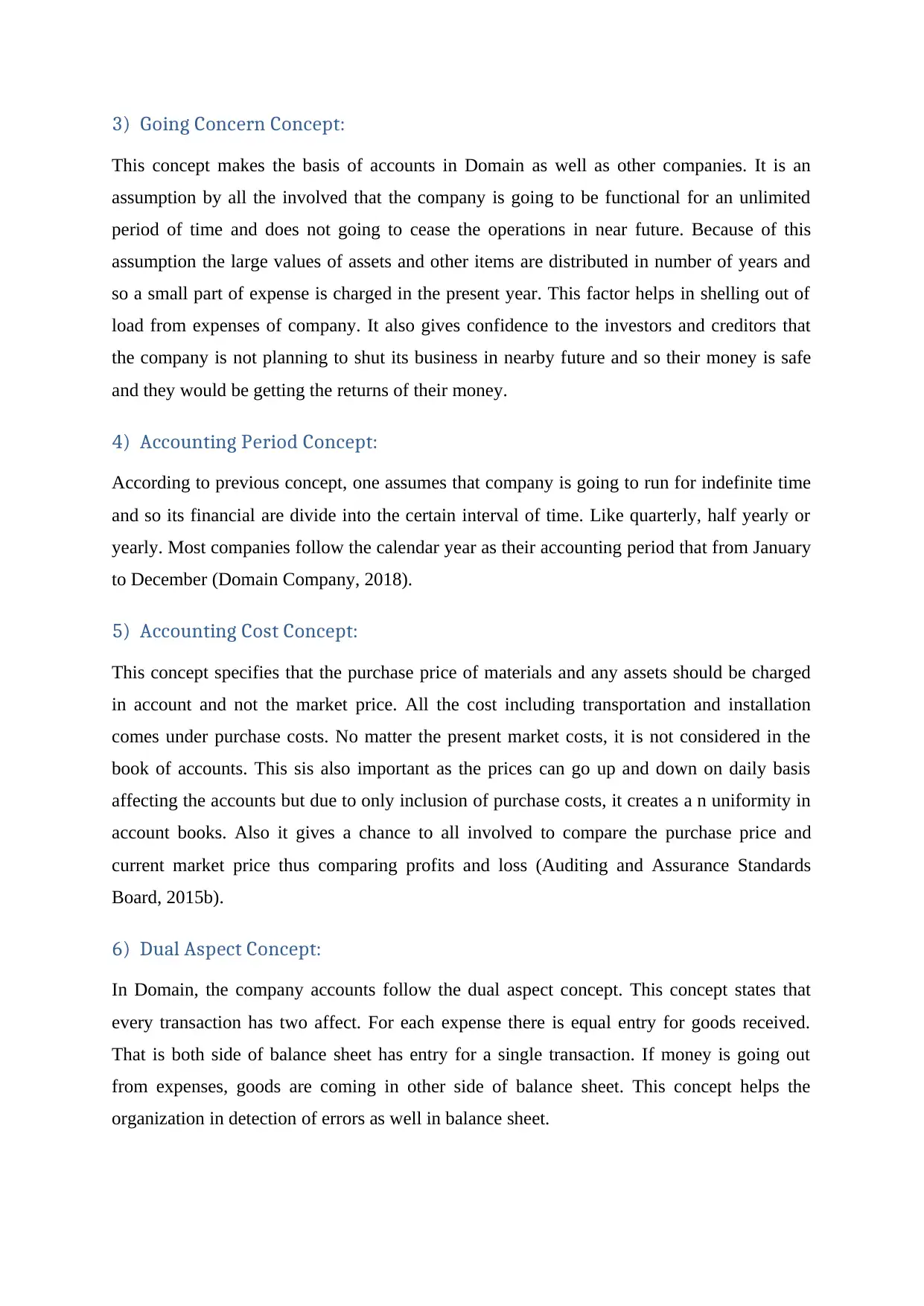
3) Going Concern Concept:
This concept makes the basis of accounts in Domain as well as other companies. It is an
assumption by all the involved that the company is going to be functional for an unlimited
period of time and does not going to cease the operations in near future. Because of this
assumption the large values of assets and other items are distributed in number of years and
so a small part of expense is charged in the present year. This factor helps in shelling out of
load from expenses of company. It also gives confidence to the investors and creditors that
the company is not planning to shut its business in nearby future and so their money is safe
and they would be getting the returns of their money.
4) Accounting Period Concept:
According to previous concept, one assumes that company is going to run for indefinite time
and so its financial are divide into the certain interval of time. Like quarterly, half yearly or
yearly. Most companies follow the calendar year as their accounting period that from January
to December (Domain Company, 2018).
5) Accounting Cost Concept:
This concept specifies that the purchase price of materials and any assets should be charged
in account and not the market price. All the cost including transportation and installation
comes under purchase costs. No matter the present market costs, it is not considered in the
book of accounts. This sis also important as the prices can go up and down on daily basis
affecting the accounts but due to only inclusion of purchase costs, it creates a n uniformity in
account books. Also it gives a chance to all involved to compare the purchase price and
current market price thus comparing profits and loss (Auditing and Assurance Standards
Board, 2015b).
6) Dual Aspect Concept:
In Domain, the company accounts follow the dual aspect concept. This concept states that
every transaction has two affect. For each expense there is equal entry for goods received.
That is both side of balance sheet has entry for a single transaction. If money is going out
from expenses, goods are coming in other side of balance sheet. This concept helps the
organization in detection of errors as well in balance sheet.
This concept makes the basis of accounts in Domain as well as other companies. It is an
assumption by all the involved that the company is going to be functional for an unlimited
period of time and does not going to cease the operations in near future. Because of this
assumption the large values of assets and other items are distributed in number of years and
so a small part of expense is charged in the present year. This factor helps in shelling out of
load from expenses of company. It also gives confidence to the investors and creditors that
the company is not planning to shut its business in nearby future and so their money is safe
and they would be getting the returns of their money.
4) Accounting Period Concept:
According to previous concept, one assumes that company is going to run for indefinite time
and so its financial are divide into the certain interval of time. Like quarterly, half yearly or
yearly. Most companies follow the calendar year as their accounting period that from January
to December (Domain Company, 2018).
5) Accounting Cost Concept:
This concept specifies that the purchase price of materials and any assets should be charged
in account and not the market price. All the cost including transportation and installation
comes under purchase costs. No matter the present market costs, it is not considered in the
book of accounts. This sis also important as the prices can go up and down on daily basis
affecting the accounts but due to only inclusion of purchase costs, it creates a n uniformity in
account books. Also it gives a chance to all involved to compare the purchase price and
current market price thus comparing profits and loss (Auditing and Assurance Standards
Board, 2015b).
6) Dual Aspect Concept:
In Domain, the company accounts follow the dual aspect concept. This concept states that
every transaction has two affect. For each expense there is equal entry for goods received.
That is both side of balance sheet has entry for a single transaction. If money is going out
from expenses, goods are coming in other side of balance sheet. This concept helps the
organization in detection of errors as well in balance sheet.
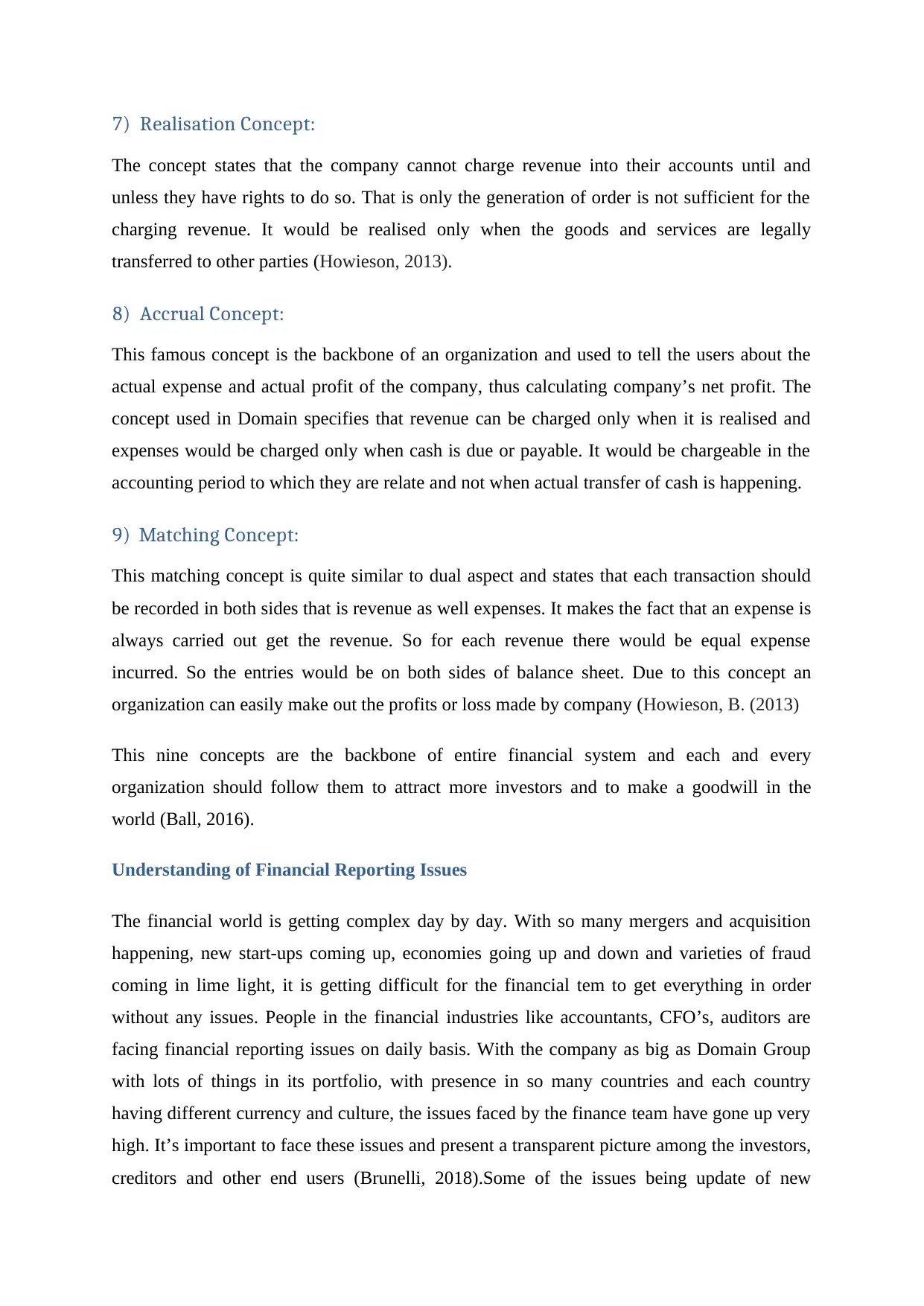
7) Realisation Concept:
The concept states that the company cannot charge revenue into their accounts until and
unless they have rights to do so. That is only the generation of order is not sufficient for the
charging revenue. It would be realised only when the goods and services are legally
transferred to other parties (Howieson, 2013).
8) Accrual Concept:
This famous concept is the backbone of an organization and used to tell the users about the
actual expense and actual profit of the company, thus calculating company’s net profit. The
concept used in Domain specifies that revenue can be charged only when it is realised and
expenses would be charged only when cash is due or payable. It would be chargeable in the
accounting period to which they are relate and not when actual transfer of cash is happening.
9) Matching Concept:
This matching concept is quite similar to dual aspect and states that each transaction should
be recorded in both sides that is revenue as well expenses. It makes the fact that an expense is
always carried out get the revenue. So for each revenue there would be equal expense
incurred. So the entries would be on both sides of balance sheet. Due to this concept an
organization can easily make out the profits or loss made by company (Howieson, B. (2013)
This nine concepts are the backbone of entire financial system and each and every
organization should follow them to attract more investors and to make a goodwill in the
world (Ball, 2016).
Understanding of Financial Reporting Issues
The financial world is getting complex day by day. With so many mergers and acquisition
happening, new start-ups coming up, economies going up and down and varieties of fraud
coming in lime light, it is getting difficult for the financial tem to get everything in order
without any issues. People in the financial industries like accountants, CFO’s, auditors are
facing financial reporting issues on daily basis. With the company as big as Domain Group
with lots of things in its portfolio, with presence in so many countries and each country
having different currency and culture, the issues faced by the finance team have gone up very
high. It’s important to face these issues and present a transparent picture among the investors,
creditors and other end users (Brunelli, 2018).Some of the issues being update of new
The concept states that the company cannot charge revenue into their accounts until and
unless they have rights to do so. That is only the generation of order is not sufficient for the
charging revenue. It would be realised only when the goods and services are legally
transferred to other parties (Howieson, 2013).
8) Accrual Concept:
This famous concept is the backbone of an organization and used to tell the users about the
actual expense and actual profit of the company, thus calculating company’s net profit. The
concept used in Domain specifies that revenue can be charged only when it is realised and
expenses would be charged only when cash is due or payable. It would be chargeable in the
accounting period to which they are relate and not when actual transfer of cash is happening.
9) Matching Concept:
This matching concept is quite similar to dual aspect and states that each transaction should
be recorded in both sides that is revenue as well expenses. It makes the fact that an expense is
always carried out get the revenue. So for each revenue there would be equal expense
incurred. So the entries would be on both sides of balance sheet. Due to this concept an
organization can easily make out the profits or loss made by company (Howieson, B. (2013)
This nine concepts are the backbone of entire financial system and each and every
organization should follow them to attract more investors and to make a goodwill in the
world (Ball, 2016).
Understanding of Financial Reporting Issues
The financial world is getting complex day by day. With so many mergers and acquisition
happening, new start-ups coming up, economies going up and down and varieties of fraud
coming in lime light, it is getting difficult for the financial tem to get everything in order
without any issues. People in the financial industries like accountants, CFO’s, auditors are
facing financial reporting issues on daily basis. With the company as big as Domain Group
with lots of things in its portfolio, with presence in so many countries and each country
having different currency and culture, the issues faced by the finance team have gone up very
high. It’s important to face these issues and present a transparent picture among the investors,
creditors and other end users (Brunelli, 2018).Some of the issues being update of new
⊘ This is a preview!⊘
Do you want full access?
Subscribe today to unlock all pages.

Trusted by 1+ million students worldwide
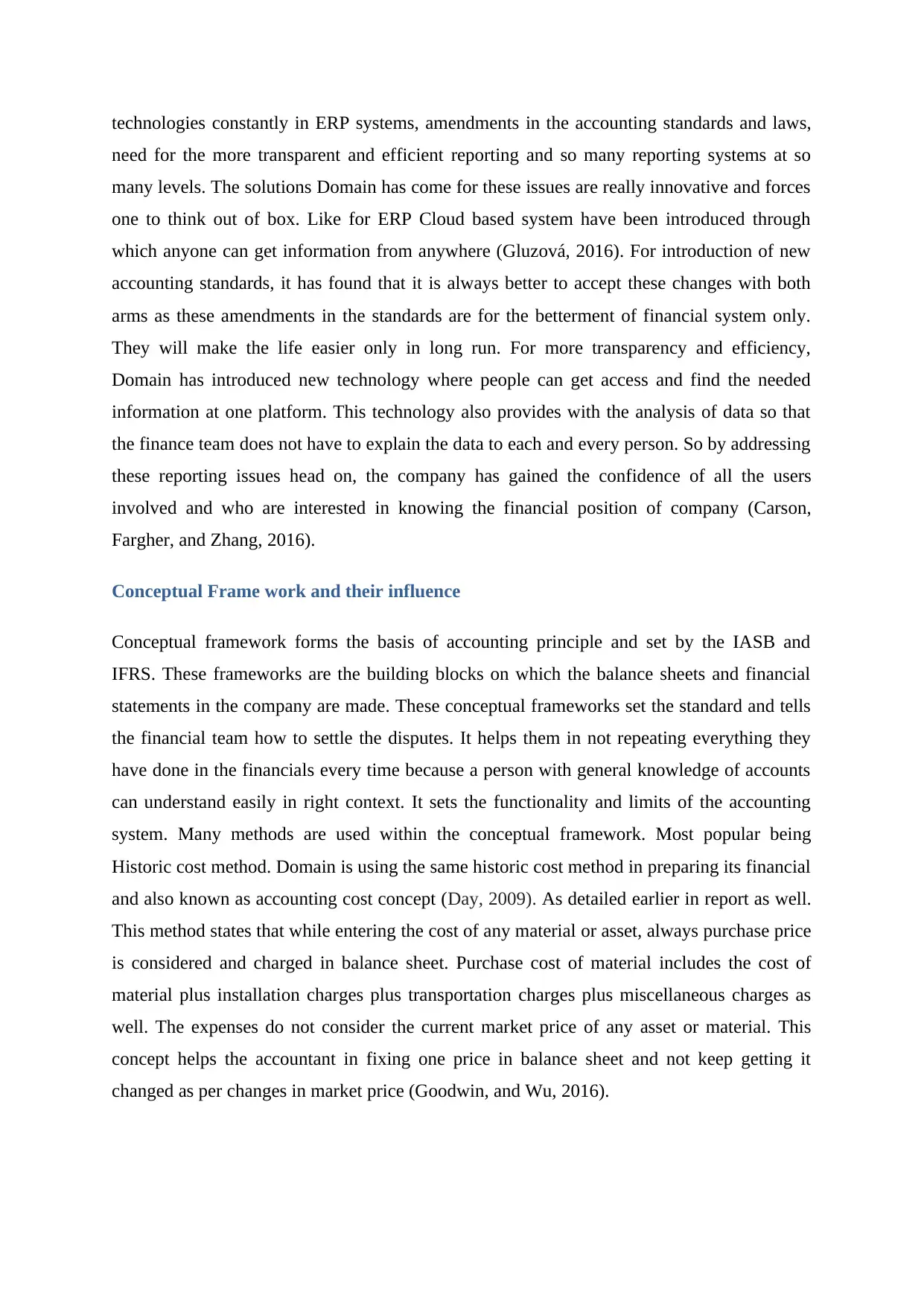
technologies constantly in ERP systems, amendments in the accounting standards and laws,
need for the more transparent and efficient reporting and so many reporting systems at so
many levels. The solutions Domain has come for these issues are really innovative and forces
one to think out of box. Like for ERP Cloud based system have been introduced through
which anyone can get information from anywhere (Gluzová, 2016). For introduction of new
accounting standards, it has found that it is always better to accept these changes with both
arms as these amendments in the standards are for the betterment of financial system only.
They will make the life easier only in long run. For more transparency and efficiency,
Domain has introduced new technology where people can get access and find the needed
information at one platform. This technology also provides with the analysis of data so that
the finance team does not have to explain the data to each and every person. So by addressing
these reporting issues head on, the company has gained the confidence of all the users
involved and who are interested in knowing the financial position of company (Carson,
Fargher, and Zhang, 2016).
Conceptual Frame work and their influence
Conceptual framework forms the basis of accounting principle and set by the IASB and
IFRS. These frameworks are the building blocks on which the balance sheets and financial
statements in the company are made. These conceptual frameworks set the standard and tells
the financial team how to settle the disputes. It helps them in not repeating everything they
have done in the financials every time because a person with general knowledge of accounts
can understand easily in right context. It sets the functionality and limits of the accounting
system. Many methods are used within the conceptual framework. Most popular being
Historic cost method. Domain is using the same historic cost method in preparing its financial
and also known as accounting cost concept (Day, 2009). As detailed earlier in report as well.
This method states that while entering the cost of any material or asset, always purchase price
is considered and charged in balance sheet. Purchase cost of material includes the cost of
material plus installation charges plus transportation charges plus miscellaneous charges as
well. The expenses do not consider the current market price of any asset or material. This
concept helps the accountant in fixing one price in balance sheet and not keep getting it
changed as per changes in market price (Goodwin, and Wu, 2016).
need for the more transparent and efficient reporting and so many reporting systems at so
many levels. The solutions Domain has come for these issues are really innovative and forces
one to think out of box. Like for ERP Cloud based system have been introduced through
which anyone can get information from anywhere (Gluzová, 2016). For introduction of new
accounting standards, it has found that it is always better to accept these changes with both
arms as these amendments in the standards are for the betterment of financial system only.
They will make the life easier only in long run. For more transparency and efficiency,
Domain has introduced new technology where people can get access and find the needed
information at one platform. This technology also provides with the analysis of data so that
the finance team does not have to explain the data to each and every person. So by addressing
these reporting issues head on, the company has gained the confidence of all the users
involved and who are interested in knowing the financial position of company (Carson,
Fargher, and Zhang, 2016).
Conceptual Frame work and their influence
Conceptual framework forms the basis of accounting principle and set by the IASB and
IFRS. These frameworks are the building blocks on which the balance sheets and financial
statements in the company are made. These conceptual frameworks set the standard and tells
the financial team how to settle the disputes. It helps them in not repeating everything they
have done in the financials every time because a person with general knowledge of accounts
can understand easily in right context. It sets the functionality and limits of the accounting
system. Many methods are used within the conceptual framework. Most popular being
Historic cost method. Domain is using the same historic cost method in preparing its financial
and also known as accounting cost concept (Day, 2009). As detailed earlier in report as well.
This method states that while entering the cost of any material or asset, always purchase price
is considered and charged in balance sheet. Purchase cost of material includes the cost of
material plus installation charges plus transportation charges plus miscellaneous charges as
well. The expenses do not consider the current market price of any asset or material. This
concept helps the accountant in fixing one price in balance sheet and not keep getting it
changed as per changes in market price (Goodwin, and Wu, 2016).
Paraphrase This Document
Need a fresh take? Get an instant paraphrase of this document with our AI Paraphraser
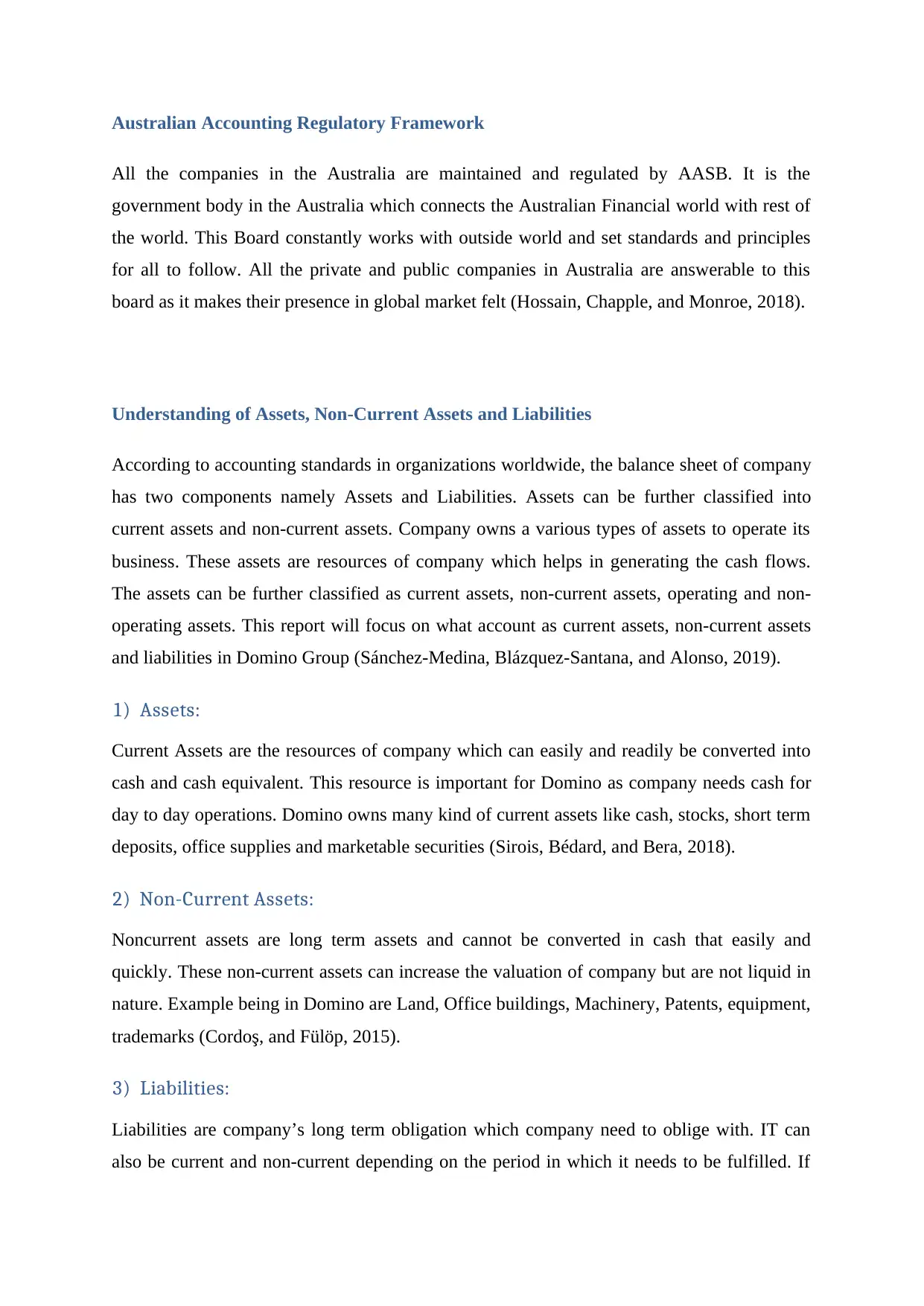
Australian Accounting Regulatory Framework
All the companies in the Australia are maintained and regulated by AASB. It is the
government body in the Australia which connects the Australian Financial world with rest of
the world. This Board constantly works with outside world and set standards and principles
for all to follow. All the private and public companies in Australia are answerable to this
board as it makes their presence in global market felt (Hossain, Chapple, and Monroe, 2018).
Understanding of Assets, Non-Current Assets and Liabilities
According to accounting standards in organizations worldwide, the balance sheet of company
has two components namely Assets and Liabilities. Assets can be further classified into
current assets and non-current assets. Company owns a various types of assets to operate its
business. These assets are resources of company which helps in generating the cash flows.
The assets can be further classified as current assets, non-current assets, operating and non-
operating assets. This report will focus on what account as current assets, non-current assets
and liabilities in Domino Group (Sánchez-Medina, Blázquez-Santana, and Alonso, 2019).
1) Assets:
Current Assets are the resources of company which can easily and readily be converted into
cash and cash equivalent. This resource is important for Domino as company needs cash for
day to day operations. Domino owns many kind of current assets like cash, stocks, short term
deposits, office supplies and marketable securities (Sirois, Bédard, and Bera, 2018).
2) Non-Current Assets:
Noncurrent assets are long term assets and cannot be converted in cash that easily and
quickly. These non-current assets can increase the valuation of company but are not liquid in
nature. Example being in Domino are Land, Office buildings, Machinery, Patents, equipment,
trademarks (Cordoş, and Fülöp, 2015).
3) Liabilities:
Liabilities are company’s long term obligation which company need to oblige with. IT can
also be current and non-current depending on the period in which it needs to be fulfilled. If
All the companies in the Australia are maintained and regulated by AASB. It is the
government body in the Australia which connects the Australian Financial world with rest of
the world. This Board constantly works with outside world and set standards and principles
for all to follow. All the private and public companies in Australia are answerable to this
board as it makes their presence in global market felt (Hossain, Chapple, and Monroe, 2018).
Understanding of Assets, Non-Current Assets and Liabilities
According to accounting standards in organizations worldwide, the balance sheet of company
has two components namely Assets and Liabilities. Assets can be further classified into
current assets and non-current assets. Company owns a various types of assets to operate its
business. These assets are resources of company which helps in generating the cash flows.
The assets can be further classified as current assets, non-current assets, operating and non-
operating assets. This report will focus on what account as current assets, non-current assets
and liabilities in Domino Group (Sánchez-Medina, Blázquez-Santana, and Alonso, 2019).
1) Assets:
Current Assets are the resources of company which can easily and readily be converted into
cash and cash equivalent. This resource is important for Domino as company needs cash for
day to day operations. Domino owns many kind of current assets like cash, stocks, short term
deposits, office supplies and marketable securities (Sirois, Bédard, and Bera, 2018).
2) Non-Current Assets:
Noncurrent assets are long term assets and cannot be converted in cash that easily and
quickly. These non-current assets can increase the valuation of company but are not liquid in
nature. Example being in Domino are Land, Office buildings, Machinery, Patents, equipment,
trademarks (Cordoş, and Fülöp, 2015).
3) Liabilities:
Liabilities are company’s long term obligation which company need to oblige with. IT can
also be current and non-current depending on the period in which it needs to be fulfilled. If
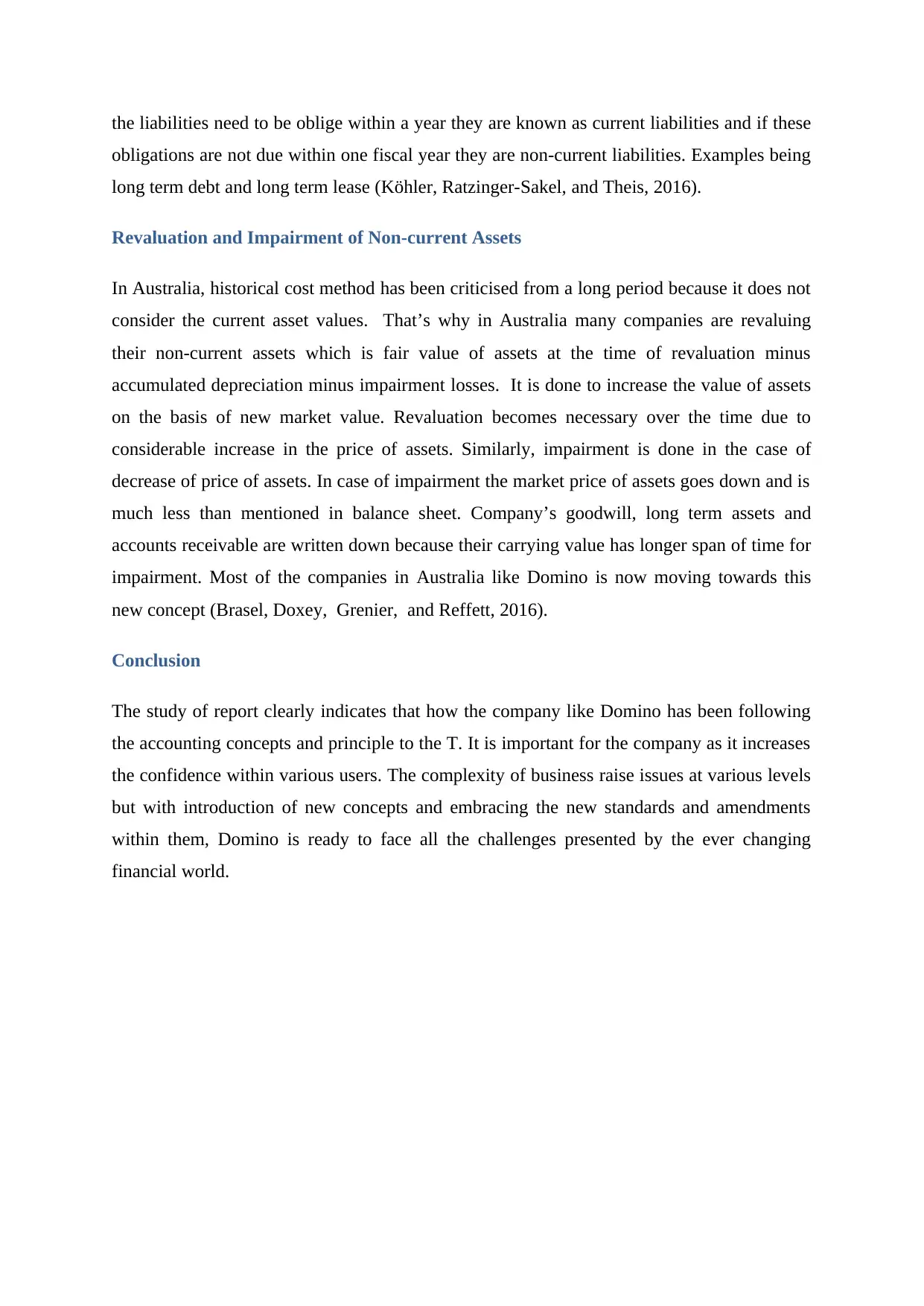
the liabilities need to be oblige within a year they are known as current liabilities and if these
obligations are not due within one fiscal year they are non-current liabilities. Examples being
long term debt and long term lease (Köhler, Ratzinger-Sakel, and Theis, 2016).
Revaluation and Impairment of Non-current Assets
In Australia, historical cost method has been criticised from a long period because it does not
consider the current asset values. That’s why in Australia many companies are revaluing
their non-current assets which is fair value of assets at the time of revaluation minus
accumulated depreciation minus impairment losses. It is done to increase the value of assets
on the basis of new market value. Revaluation becomes necessary over the time due to
considerable increase in the price of assets. Similarly, impairment is done in the case of
decrease of price of assets. In case of impairment the market price of assets goes down and is
much less than mentioned in balance sheet. Company’s goodwill, long term assets and
accounts receivable are written down because their carrying value has longer span of time for
impairment. Most of the companies in Australia like Domino is now moving towards this
new concept (Brasel, Doxey, Grenier, and Reffett, 2016).
Conclusion
The study of report clearly indicates that how the company like Domino has been following
the accounting concepts and principle to the T. It is important for the company as it increases
the confidence within various users. The complexity of business raise issues at various levels
but with introduction of new concepts and embracing the new standards and amendments
within them, Domino is ready to face all the challenges presented by the ever changing
financial world.
obligations are not due within one fiscal year they are non-current liabilities. Examples being
long term debt and long term lease (Köhler, Ratzinger-Sakel, and Theis, 2016).
Revaluation and Impairment of Non-current Assets
In Australia, historical cost method has been criticised from a long period because it does not
consider the current asset values. That’s why in Australia many companies are revaluing
their non-current assets which is fair value of assets at the time of revaluation minus
accumulated depreciation minus impairment losses. It is done to increase the value of assets
on the basis of new market value. Revaluation becomes necessary over the time due to
considerable increase in the price of assets. Similarly, impairment is done in the case of
decrease of price of assets. In case of impairment the market price of assets goes down and is
much less than mentioned in balance sheet. Company’s goodwill, long term assets and
accounts receivable are written down because their carrying value has longer span of time for
impairment. Most of the companies in Australia like Domino is now moving towards this
new concept (Brasel, Doxey, Grenier, and Reffett, 2016).
Conclusion
The study of report clearly indicates that how the company like Domino has been following
the accounting concepts and principle to the T. It is important for the company as it increases
the confidence within various users. The complexity of business raise issues at various levels
but with introduction of new concepts and embracing the new standards and amendments
within them, Domino is ready to face all the challenges presented by the ever changing
financial world.
⊘ This is a preview!⊘
Do you want full access?
Subscribe today to unlock all pages.

Trusted by 1+ million students worldwide
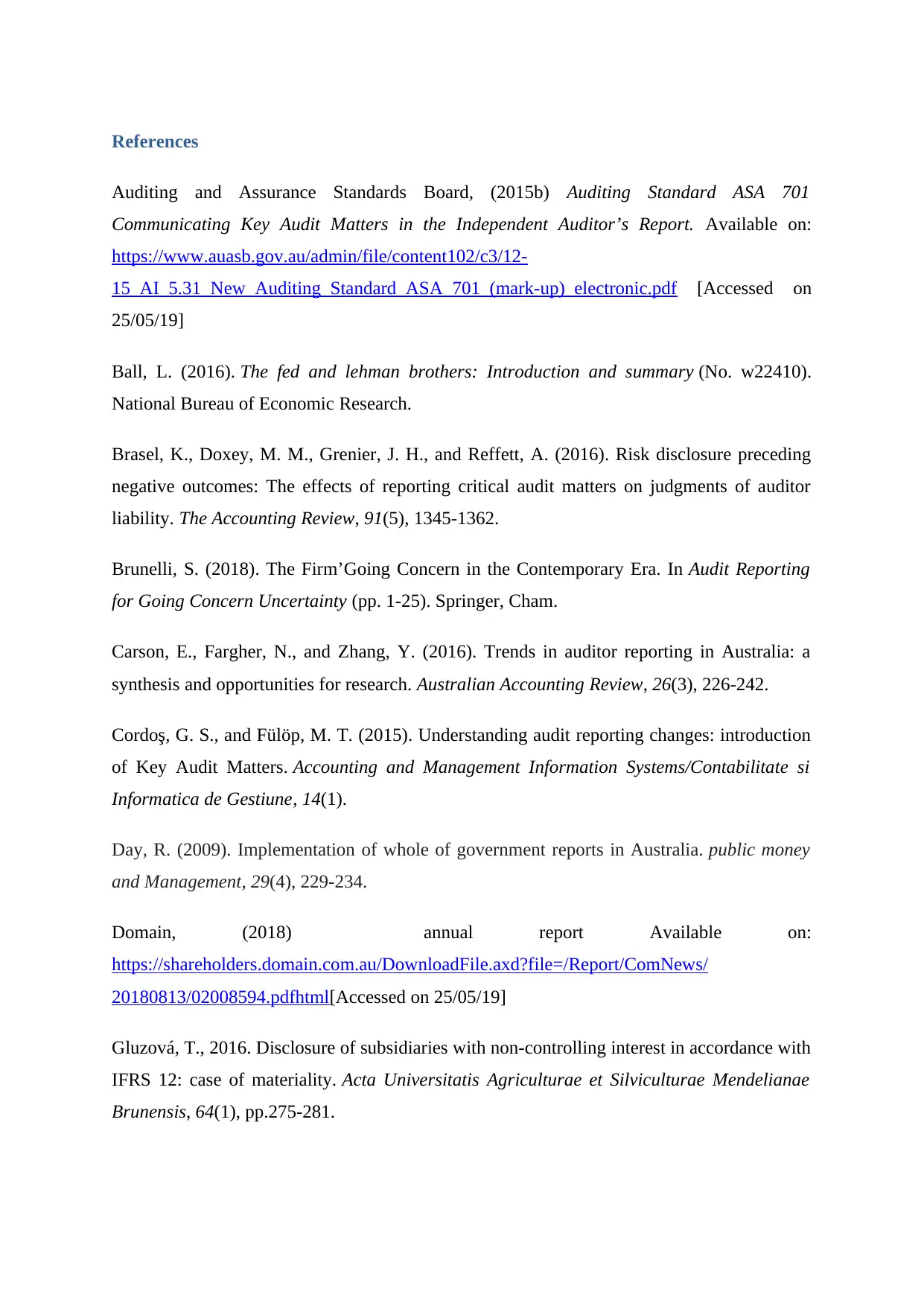
References
Auditing and Assurance Standards Board, (2015b) Auditing Standard ASA 701
Communicating Key Audit Matters in the Independent Auditor’s Report. Available on:
https://www.auasb.gov.au/admin/file/content102/c3/12-
15_AI_5.31_New_Auditing_Standard_ASA_701_(mark-up)_electronic.pdf [Accessed on
25/05/19]
Ball, L. (2016). The fed and lehman brothers: Introduction and summary (No. w22410).
National Bureau of Economic Research.
Brasel, K., Doxey, M. M., Grenier, J. H., and Reffett, A. (2016). Risk disclosure preceding
negative outcomes: The effects of reporting critical audit matters on judgments of auditor
liability. The Accounting Review, 91(5), 1345-1362.
Brunelli, S. (2018). The Firm’Going Concern in the Contemporary Era. In Audit Reporting
for Going Concern Uncertainty (pp. 1-25). Springer, Cham.
Carson, E., Fargher, N., and Zhang, Y. (2016). Trends in auditor reporting in Australia: a
synthesis and opportunities for research. Australian Accounting Review, 26(3), 226-242.
Cordoş, G. S., and Fülöp, M. T. (2015). Understanding audit reporting changes: introduction
of Key Audit Matters. Accounting and Management Information Systems/Contabilitate si
Informatica de Gestiune, 14(1).
Day, R. (2009). Implementation of whole of government reports in Australia. public money
and Management, 29(4), 229-234.
Domain, (2018) annual report Available on:
https://shareholders.domain.com.au/DownloadFile.axd?file=/Report/ComNews/
20180813/02008594.pdfhtml[Accessed on 25/05/19]
Gluzová, T., 2016. Disclosure of subsidiaries with non-controlling interest in accordance with
IFRS 12: case of materiality. Acta Universitatis Agriculturae et Silviculturae Mendelianae
Brunensis, 64(1), pp.275-281.
Auditing and Assurance Standards Board, (2015b) Auditing Standard ASA 701
Communicating Key Audit Matters in the Independent Auditor’s Report. Available on:
https://www.auasb.gov.au/admin/file/content102/c3/12-
15_AI_5.31_New_Auditing_Standard_ASA_701_(mark-up)_electronic.pdf [Accessed on
25/05/19]
Ball, L. (2016). The fed and lehman brothers: Introduction and summary (No. w22410).
National Bureau of Economic Research.
Brasel, K., Doxey, M. M., Grenier, J. H., and Reffett, A. (2016). Risk disclosure preceding
negative outcomes: The effects of reporting critical audit matters on judgments of auditor
liability. The Accounting Review, 91(5), 1345-1362.
Brunelli, S. (2018). The Firm’Going Concern in the Contemporary Era. In Audit Reporting
for Going Concern Uncertainty (pp. 1-25). Springer, Cham.
Carson, E., Fargher, N., and Zhang, Y. (2016). Trends in auditor reporting in Australia: a
synthesis and opportunities for research. Australian Accounting Review, 26(3), 226-242.
Cordoş, G. S., and Fülöp, M. T. (2015). Understanding audit reporting changes: introduction
of Key Audit Matters. Accounting and Management Information Systems/Contabilitate si
Informatica de Gestiune, 14(1).
Day, R. (2009). Implementation of whole of government reports in Australia. public money
and Management, 29(4), 229-234.
Domain, (2018) annual report Available on:
https://shareholders.domain.com.au/DownloadFile.axd?file=/Report/ComNews/
20180813/02008594.pdfhtml[Accessed on 25/05/19]
Gluzová, T., 2016. Disclosure of subsidiaries with non-controlling interest in accordance with
IFRS 12: case of materiality. Acta Universitatis Agriculturae et Silviculturae Mendelianae
Brunensis, 64(1), pp.275-281.
Paraphrase This Document
Need a fresh take? Get an instant paraphrase of this document with our AI Paraphraser
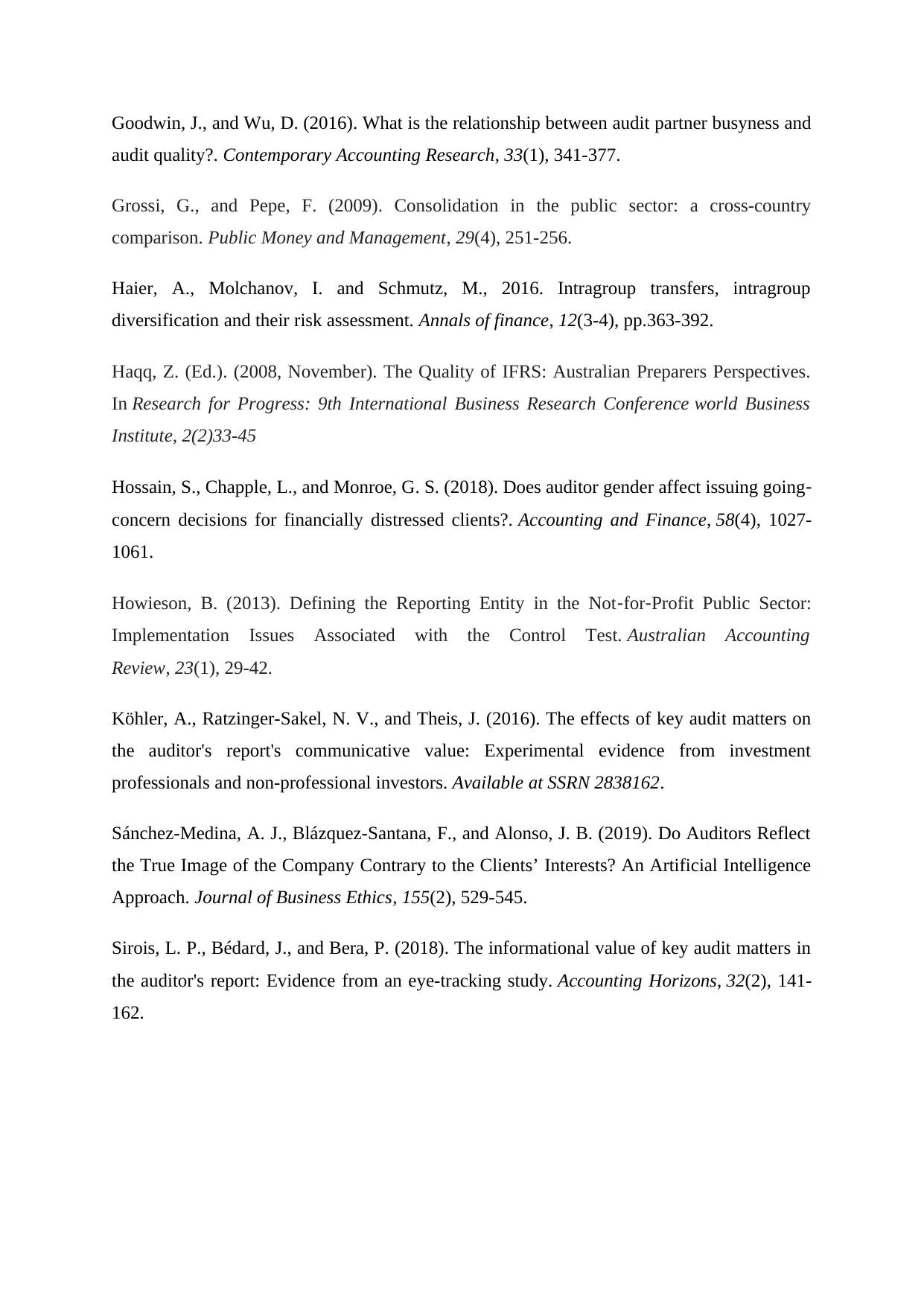
Goodwin, J., and Wu, D. (2016). What is the relationship between audit partner busyness and
audit quality?. Contemporary Accounting Research, 33(1), 341-377.
Grossi, G., and Pepe, F. (2009). Consolidation in the public sector: a cross-country
comparison. Public Money and Management, 29(4), 251-256.
Haier, A., Molchanov, I. and Schmutz, M., 2016. Intragroup transfers, intragroup
diversification and their risk assessment. Annals of finance, 12(3-4), pp.363-392.
Haqq, Z. (Ed.). (2008, November). The Quality of IFRS: Australian Preparers Perspectives.
In Research for Progress: 9th International Business Research Conference world Business
Institute, 2(2)33-45
Hossain, S., Chapple, L., and Monroe, G. S. (2018). Does auditor gender affect issuing going‐
concern decisions for financially distressed clients?. Accounting and Finance, 58(4), 1027-
1061.
Howieson, B. (2013). Defining the Reporting Entity in the Not‐for‐Profit Public Sector:
Implementation Issues Associated with the Control Test. Australian Accounting
Review, 23(1), 29-42.
Köhler, A., Ratzinger-Sakel, N. V., and Theis, J. (2016). The effects of key audit matters on
the auditor's report's communicative value: Experimental evidence from investment
professionals and non-professional investors. Available at SSRN 2838162.
Sánchez-Medina, A. J., Blázquez-Santana, F., and Alonso, J. B. (2019). Do Auditors Reflect
the True Image of the Company Contrary to the Clients’ Interests? An Artificial Intelligence
Approach. Journal of Business Ethics, 155(2), 529-545.
Sirois, L. P., Bédard, J., and Bera, P. (2018). The informational value of key audit matters in
the auditor's report: Evidence from an eye-tracking study. Accounting Horizons, 32(2), 141-
162.
audit quality?. Contemporary Accounting Research, 33(1), 341-377.
Grossi, G., and Pepe, F. (2009). Consolidation in the public sector: a cross-country
comparison. Public Money and Management, 29(4), 251-256.
Haier, A., Molchanov, I. and Schmutz, M., 2016. Intragroup transfers, intragroup
diversification and their risk assessment. Annals of finance, 12(3-4), pp.363-392.
Haqq, Z. (Ed.). (2008, November). The Quality of IFRS: Australian Preparers Perspectives.
In Research for Progress: 9th International Business Research Conference world Business
Institute, 2(2)33-45
Hossain, S., Chapple, L., and Monroe, G. S. (2018). Does auditor gender affect issuing going‐
concern decisions for financially distressed clients?. Accounting and Finance, 58(4), 1027-
1061.
Howieson, B. (2013). Defining the Reporting Entity in the Not‐for‐Profit Public Sector:
Implementation Issues Associated with the Control Test. Australian Accounting
Review, 23(1), 29-42.
Köhler, A., Ratzinger-Sakel, N. V., and Theis, J. (2016). The effects of key audit matters on
the auditor's report's communicative value: Experimental evidence from investment
professionals and non-professional investors. Available at SSRN 2838162.
Sánchez-Medina, A. J., Blázquez-Santana, F., and Alonso, J. B. (2019). Do Auditors Reflect
the True Image of the Company Contrary to the Clients’ Interests? An Artificial Intelligence
Approach. Journal of Business Ethics, 155(2), 529-545.
Sirois, L. P., Bédard, J., and Bera, P. (2018). The informational value of key audit matters in
the auditor's report: Evidence from an eye-tracking study. Accounting Horizons, 32(2), 141-
162.

⊘ This is a preview!⊘
Do you want full access?
Subscribe today to unlock all pages.

Trusted by 1+ million students worldwide
1 out of 12
Related Documents
Your All-in-One AI-Powered Toolkit for Academic Success.
+13062052269
info@desklib.com
Available 24*7 on WhatsApp / Email
![[object Object]](/_next/static/media/star-bottom.7253800d.svg)
Unlock your academic potential
Copyright © 2020–2025 A2Z Services. All Rights Reserved. Developed and managed by ZUCOL.




